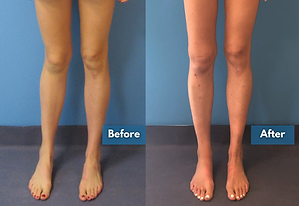Rotational Deformities
Rotational deformities of the lower limbs are common but are hard to recognize. Even experienced doctors will miss these problematic conditions. A rotational deformity of the tibia can be identified when the feet don’t line up with the knees. The feet can either turn inward (internal torsion) or outward (external torsion).
.png)
External Tibia Rotation -
Knees Point Inwards

Rotational deformities make activities such as running, yoga, and cycling challenging. Rotational deformities of the femur and hip are more subtle. Patients may walk with the feet and knees turned inward (anteversion) or outward (retroversion). Often femoral anteversion will be accompanied by external tibial torsion creating a complex two-level rotational deformity (miserable malalignment or tetratorsional malalignment). Rotational Deformities may also cause dislocating kneecaps.
Causes
Many rotational deformities are congenital which means they occur from the time of birth and affect both lower limbs. Rotational deformities can also occur as a result of trauma to the tibia or femur.
Rotational deformities can also be accompanied by bowlegs or knock knees. Standard treatments for bowlegs or knock knees will not fix the rotational deformity.
External Femoral Rotation - Knees Outwards
External Femoral Rotation With Knock Knees
Symptoms Of Rotation
Rotational deformities do not create the same obvious visual malalignment seen with bowlegs and knock knees. Symptoms may include:
-
Pain in the hip, knee, or ankle
-
Difficulty running, cycling, achieving yoga poses.
-
Trouble maintaining balance

Femoral Anteversion
Treatment
A rotational deformity is a structural issue that can only be fixed through re-alignment surgery. Fortunately, this is one of the least invasive deformity surgeries and is performed through very small incisions.
The femur and tibia bones are hollow and allow for the insertion of a thin titanium rod which supports the correction. Sometimes the deformity needs to be corrected with a plate or with an external fixator depending on the unique needs of the patient.
.png)
Correction through Femoral Plates and Rods
.png)
Recovery
Surgery is performed at the Hospital for Special Surgery in New York City. Dr. Fragomen personally performs all of the procedures and is supported by a professional surgical team. Patients are admitted to the hospital after surgery for an average of 2 nights where they will receive multimodal pain control from the HSS pain team and physical therapy for crutch training.
Patients can expect to be on crutches for about 6 weeks. Once the osteotomy site has healed patients may resume unrestricted physical activity. Eventually the rods and plates will need to be removed in an ambulatory setting.

Correction through Femoral Plate
and Tibia Rod

Medical Questions
Dr. Fragomen: fragomena@hss.edu
Erica Lenihan, RN: lenihane@hss.edu
Zac Edelman, PA: edelmanz@hss.edu
Eric Lau, PA: laue@hss.edu
Scheduling and Insurance Inquiries
Book An
Appointment Today!
519 E 72nd Street Suite 204, NY, NY 10021




